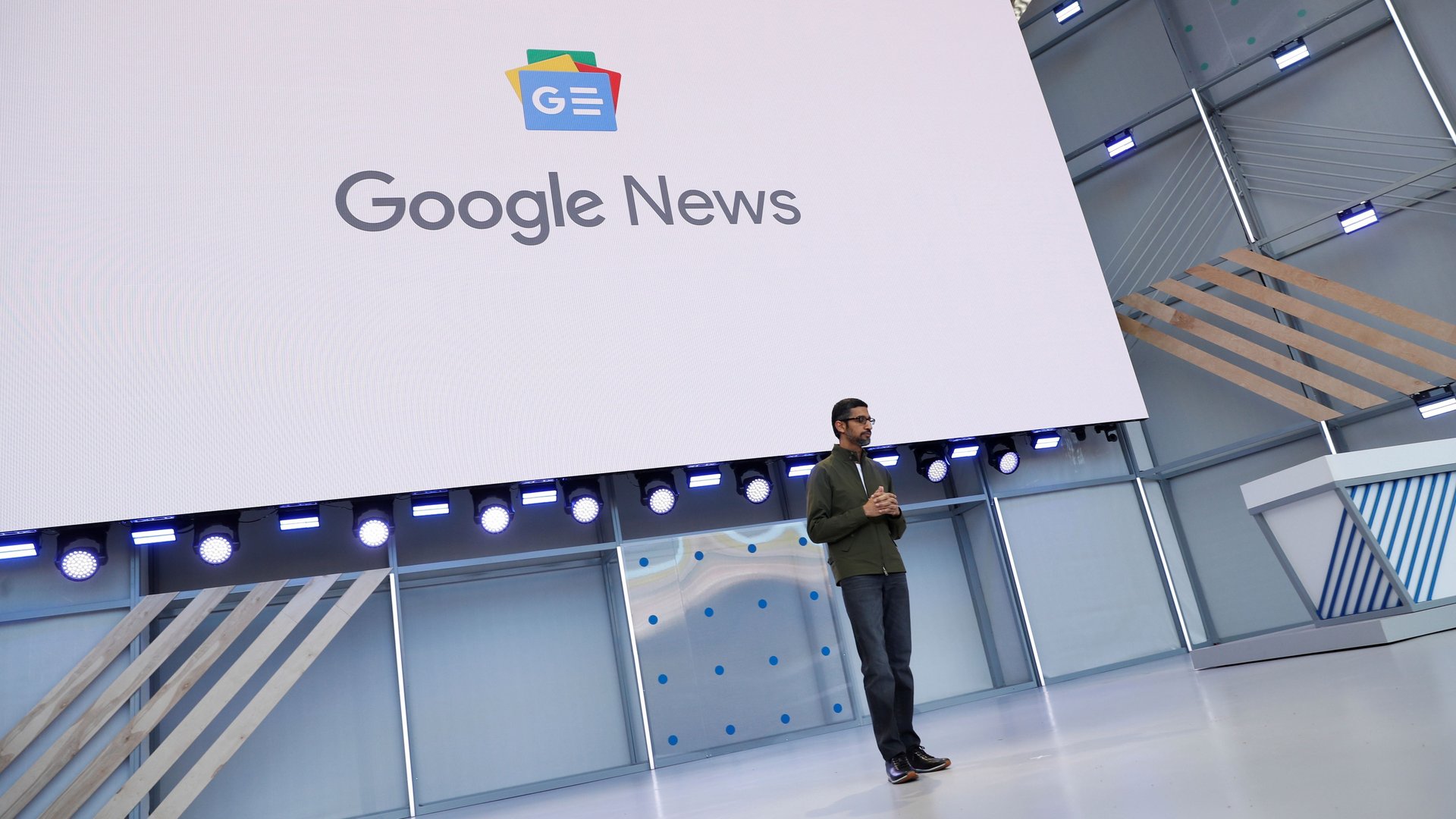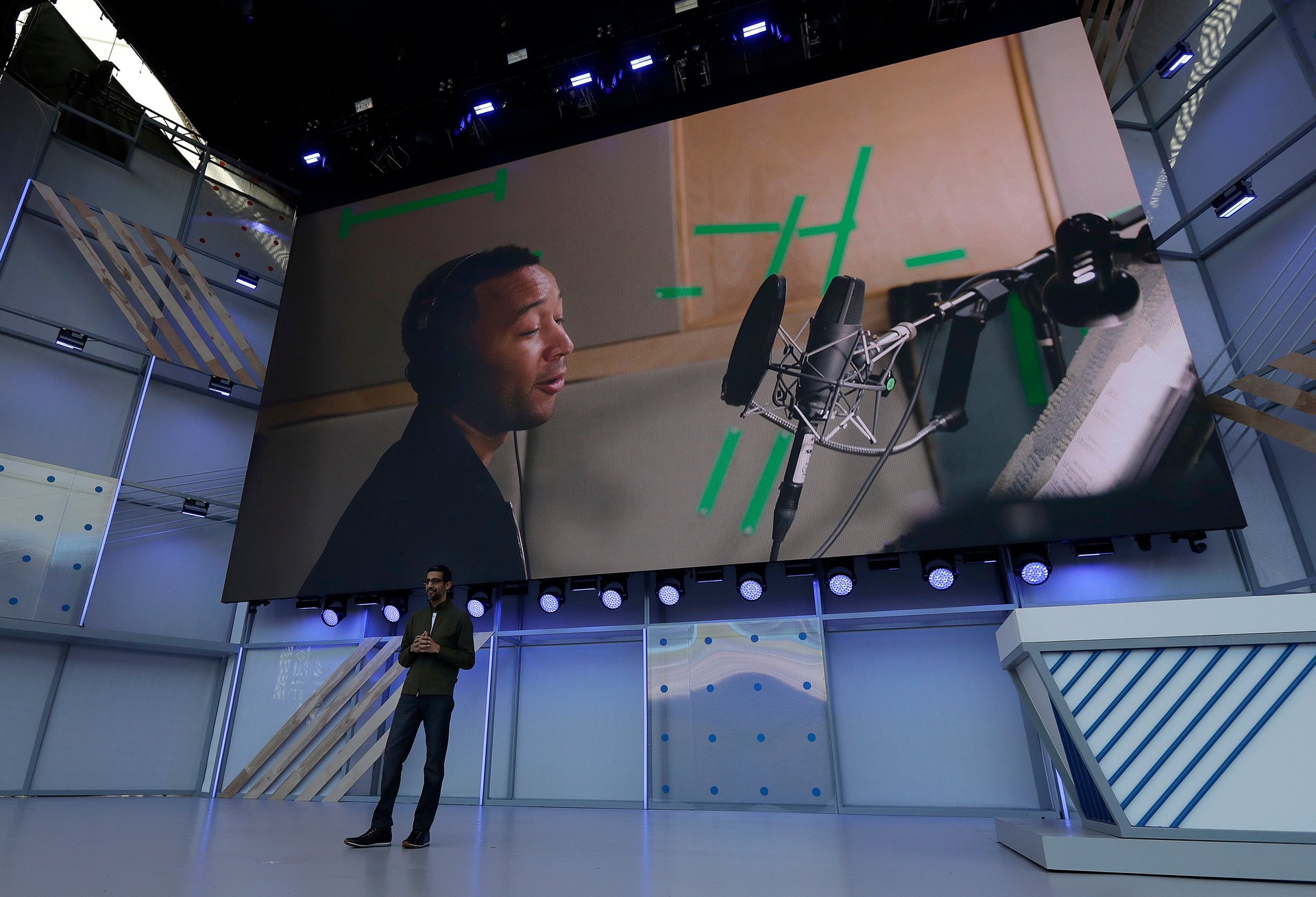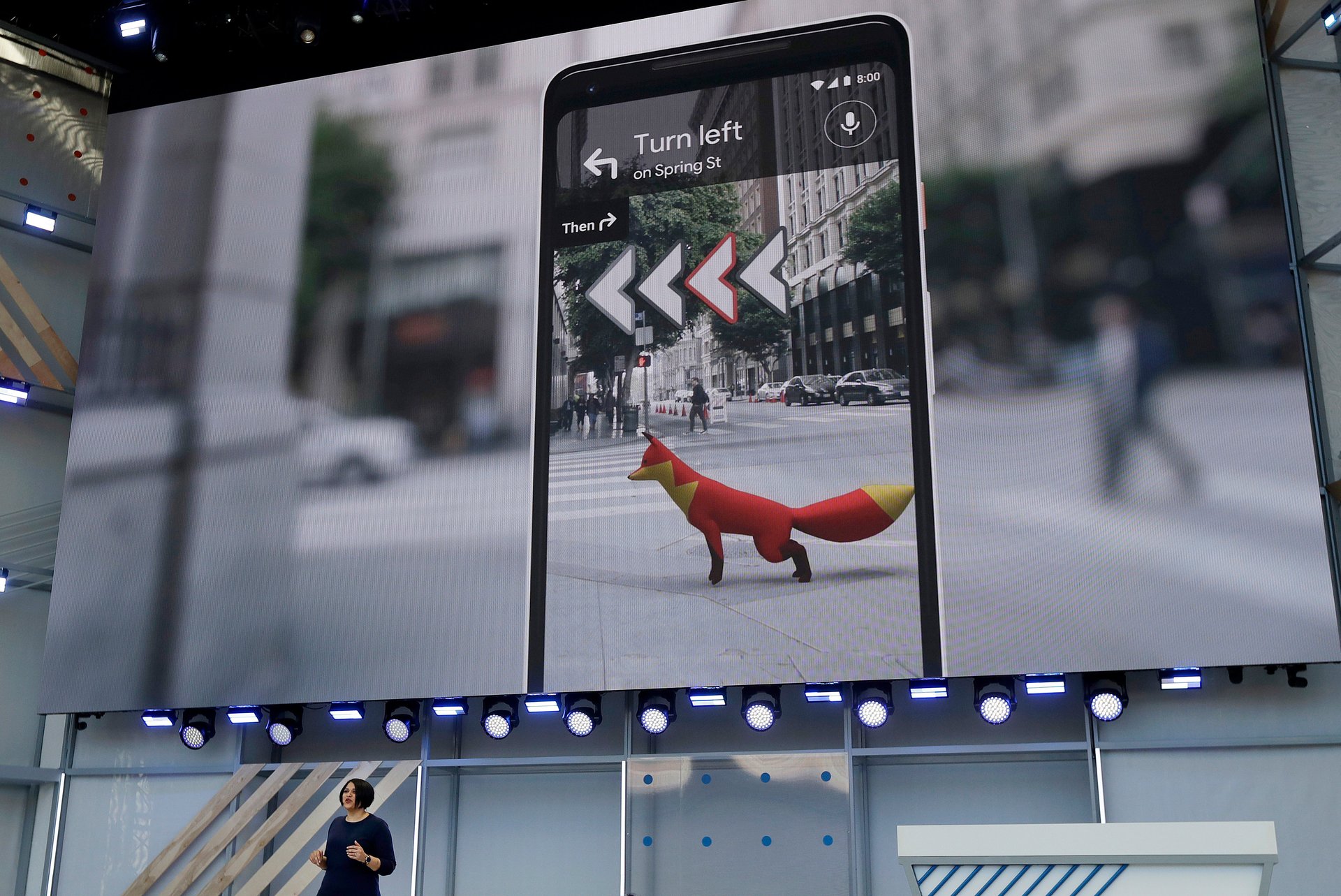Everything Google announced at its 2018 I/O developers conference
At a sunny Shoreline Amphitheatre, in Mountain View, California, Google kicked off its annual I/O developers conference May 8. After a brief keynote speech on how the technology company approaches its product development with a “deep sense of responsibility,” CEO Sundar Pichai ceded the stage to his deputies to show off what the company has been working on.


At a sunny Shoreline Amphitheatre, in Mountain View, California, Google kicked off its annual I/O developers conference May 8. After a brief keynote speech on how the technology company approaches its product development with a “deep sense of responsibility,” CEO Sundar Pichai ceded the stage to his deputies to show off what the company has been working on.
Here’s a rundown of just about everything Google announced at the keynote:
Android P
Google called its latest operating system a “vision of AI at the core of the operating system.” Here’s a few of the new features it previewed for the OS, which will likely launch later in the year:
A simpler design. The Google version of Android is getting simpler. Android P replaces the three buttons at the bottom of the operating system with a single home button. From there,the technology company approaches its product development, and access shortcuts to open the five apps the operating system thinks you’re you’re most likely to want. A second swipe up will reveal all the apps on your phone. Swiping sideways on the home button will allow you to scroll through all the apps you have open.
Shush. Android P will feature a new “shush” mode, where it’ll turn off all notifications, pings, buzzes, and sounds if you rest it on its screen, with the aim of making users more present in meetings and other times they shouldn’t be checking their phones. Calls from important people (like family members) will still go through.
Wind down. This new mode will turn the phone’s screen to greyscale past a certain hour, which Google says helps to dissuade you from continuing to use your phone in bed. But you’ll always be able to turn the feature off if you don’t feel like sleeping right now.
Get off your phone. The app utility dashboard in Android will show you how often you’re using certain apps. In the past, this has just been to show y0u how much battery they’re consuming, but now it’ll help you stay mindful of how often you’re staring at your phone. You’ll also be able to set apps to remind you to take breaks from using them.
Rotation control. You’ll now be able to control when your phone rotates its screen: Instead of rotation lock being an on-or-off switch, the operating system will show a little icon when you turn your phone, allowing you to toggle rotation lock if you want it off for this specific screen, but on in general.

Better battery management. Android P understands which apps you use a lot, and will attempt to expend battery only on those. Google said it had seen a 30% reduction in processor wake-ups (how often the device was turning on the processor) in beta tests of P. It’s also introducing adaptive brightness settings, where Android will learn how bright you like your phone in various settings.
App actions. Android will get better at understanding how you use your phone over time. If you always call your sister in the evening, or perhaps go for a run after work, it’ll now suggest those actions right from the launcher screen. If you connect headphones, Android will suggest you resume the album you were last listening to on Spotify. The Google search bar will now also support deep links to apps. For example, if you search for the film Avengers: Infinity War in the search bar, it’ll show you the option to book tickets on Fandango or watch the trailer on YouTube, right from the search results suggestions.
Slices. Developers will be able to add their own information into the Google search bar as well: For example, if you start typing “Lyft” to open the app and request a ride somewhere, you’ll now see the time it’ll take to get a car, and how long it would take to get to your home or office.
ML Kit. Machine learning tools, like image labeling, text recognition, and facial recognition, and other AI tools that Google has developed, will now be available to developers to make their apps more intelligent, in a suite of software Google is calling ML Kit.
Android P beta. Google is launching a beta of its next operating system today. It’ll be available for select devices that Google makes, including the Pixel 2, as well as phones built by Essential, OnePlus, Nokia, Vivo, Xiaomi, Oppo, Vivo, and Sony.
Google didn’t say when Android P would be fully released, or what the P will stand for, but if previous years are anything to go by, we’ll likely learn more in the fall.
AI updates
Natural conversations on Google Assistant. You no longer have to continually say “Hey Google” to talk to your Google assistant. Once you’ve gotten the assistant’s attention by saying it once, you’ll be able to ask it follow-up questions naturally. For example, you’d be able to have a conversation like this:
“Hey Google, turn on the Warriors game.”
“Ok.”
“Oh, and can you turn off the lights?”
And Google will listen to and carry out your commands.
Multiple queries at once. You’ll now be able to string together questions and commands at once, and Assistant will be able to infer what you’re after if you ask it multiple things at once. Onstage, Google asked: “Who was the governor of California when Kevin Durant was drafted, and who drafted him?” Assistant had no problem figuring out that these were all separate questions, answering that Arnold Schwarzenegger was governor in 2007, and that Seattle drafted Durant that year.
Pretty please. Much like its main competitor in the virtual assistant market, Google announced that it’s built a function that reinforces polite behavior in kids when they ask Assistant things. When people say “please” when requesting something of Assistant, it’ll start its response with something like, “thanks for asking nicely.”
Natural voices. Google built a new structure for the voice in its assistant called “Wavenet,” which introduces six more natural-sounding voices, including, for some reason, the dulcet tones of singer John Legend.

Other Assistant updates. Google is working with Starbucks, Dunkin’ Donuts, Dominos, and others, to bring voice ordering to Assistant. You’ll soon be able to order your regular orders right from the app. Users will also be able to share their arrival times when navigating somewhere with Google Maps. There will be updates for Assistant in other formats, like on the forthcoming touchscreen displays from Lenovo and others that feature Google Assistant, and cars running Google Auto.
Lens updates. Google Lens, the computer vision technology built into Google Camera, can now scan the world in real time. Point your phone around you, and it should be able to figure out what you’re looking at, whether that’s the name of a book, how tall a building is, or what sort of dog is in front of you.
Google said all of these features will launch later in the year.
TPU 3.0. Google also announced a third version of its Tensor Processing Unit, a chip designed for high-powered AI devices. The new version is eight times more powerful than the version it launched last year, Pichai said.
AI calls
Google announced a new feature for Assistant called Duplex. In the future, users will be able ask Assistant to book appointments and reservations, and the assistant itself will call up the business on its own, and have a conversation with them to make the booking.
Pichai showed off conversations that took place between Assistant and real humans to book a haircut appointment and find out whether a reservation would be needed at a restaurant. Although these conversations were relatively straightforward, in both cases, they convinced the human that they were speaking to another human. Assistant even added umms and uhhs into its speech.
Pichai didn’t give a timeline for when Duplex would be available to users, adding that the company wants to get this technology right before it unleashes it on the world, but it was impressive demonstration on where the company’s AI research stands today.
Google Maps updates
Augmented reality in maps. Using your phone’s camera, you’ll soon be able to open up Maps, and have the app point you in the right direction as you navigate to your destination. There will be arrows floating above you, pointing you in the right direction. Google said it’s also toying with having a cartoon fox show you the way to go. Opening the camera in Maps will also give you an augmented view of the businesses and events nearby where you are.
For You. Google is introducing a new tab in Maps that will show you things you should be interested in, including new businesses opening in your area, and places you will like based on reviews you’ve given in the past, and places the app knows you’ve visited. Updates from businesses you’ve visited will also be available in this tab, and soon, you’ll be able to book appointments right from this screen.
Lists. If you’re trying to figure out where to go to lunch with friends, you can now make a simple list in Google Maps of possibilities, and share it with friends, instead of copying a bunch of links. Your friends can also add their own suggestions.
These updates will roll out later this summer.

Smart compose on Gmail
If typing emails is just too much of a chore, Google is about to make things a bit easier for you. It will soon roll out an assistive technology called “smart compose” which will literally finish users’ sentences for them. When you start typing common phrases or pieces of information about yourself that Google knows (like your address), Gmail will now suggest what to type. Press tab, and it’ll write in its suggestion.
This is essentially a super-powered version of the “Smart reply” function Google introduced to all Gmail users when it launched a redesigned version of the app last month, which automatically suggests responses to emails. The new feature should be available in the next few weeks to personal Gmail users, and in the next few months for professional G Suite users.
Updates to Google Photos
Google Photos will now automatically recognize users’ friends in photos, and suggest that they share photos with them. Google also introduced new effects, including the ability to colorize old black-and-white photos. Users will also be able to turn photos of documents into PDFs, which means no one really needs a scanner anymore.
Self-driving car updates
Google gave a bit of stage time to one of its Alphabet sister companies, Waymo. The company’s CEO, John Krafcik, took the stage to announce that Waymo will launch a full self-driving car ride-hailing service later this year. The service will first be available in Phoenix, Arizona, which has been one of the cities where Waymo has been testing its vehicles in recent years.

Google News refresh
Google rebuilt its news app around AI. It’ll constantly show you the top five stories it believes will interest you. The app is constantly trawling the web for local stories and your search history to figure out what you actually want to learn about. It’ll bring in less traditional sources of news as well, including YouTube and podcasts. ”Our AI constantly reads the firehose of the internet for you,” Google said.
It’ll also show you context around the news, which it calls “full coverage,” including headlines, tweets and other stories that give more context, as well as a timeline of the news story in question. Everyone, regardless of their political leanings or location, will see the same information.
You can also now subscribe to publications through Google News. Instead of filling out forms on news sites and entering credit card information, you can just use the credit card you have stored on file with Google, and tap a single button to subscribe.
The updated News rolls out in 127 countries from today, and should be available to everyone next week.